Seven years ago we ran a series of photographs by Jason Florio documenting life in Taliban-controlled Afghanistan just before the 2001 US-led invasion. Since then the country has been in the midst of a slow-burning war, where portions simmer down and stabilize while others periodically flare up, as seen most recently in the renewed fighting between Taliban-associated insurgents and coalition forces in the south over the past month. We felt we were long overdue for a personal update, so we called our friend Chris Cole who’s been working with the UN in Afghanistan to see how it’s been going and he sent us these pictures. Vice: How did you end up in Afghanistan?
Vice: How did you end up in Afghanistan?
Chris Cole: I originally went to Afghanistan to do research for my postgraduate thesis in social anthropology on the effectiveness of the governance strategy being employed by the UN there. When I arrived it quickly became apparent that the security and political climates were changing so rapidly as to make my research plan completely unrealistic. I soon found a position working with the UN Development Program, which supports the Afghani government’s reconstruction efforts.Just for a little bit of scale, how would you describe the size of the area of Afghanistan that you covered while you were there?
I managed to get to nearly all of Afghanistan’s main regions, though typically on short, hectic monitoring missions that didn’t allow much time for exploring. The country is about the size of Texas and beyond the main ring road, which connects Kabul to the country’s other main cities—Kandahar, Heart, and Mazar-i-Sharif—the transportation infrastructure is poor. Traveling to remote provinces in winter often means many long days of driving on dangerous frozen roads in insecure areas.Were people friendly toward you?
Westerners who are not especially familiar with the history and social dynamics at work in Afghanistan tend to think that most Afghans are anti-American or Islamic extremists. The plain fact is that a very slim minority of the Afghan population—likely less than 1 percent—even tacitly sympathizes with the views of the Islamist Jihadis who make up the insurgency. Those families in Southern Afghanistan who allow insurgents to sleep in their homes and eat their food nearly always do so out of fear for their lives and because they cannot rely on NATO and Coalition troops to protect them. They don’t have some principle hostility toward Westerners or the Western way of life. While I was in the country I never felt as though I was the subject of any direct hostility. Afghans have a reputation for their hospitality that they live up to in my experience.Recent reports suggest it’s comprised of roughly 20,000 armed men, many of whom have come from Pakistan or elsewhere in the Islamic world. Their operations are concentrated in Afghanistan’s South along the Pashtun tribal belt, which straddles the border with Pakistan and encompasses some very mountainous terrain. Though “Taliban” is perhaps a wanting label for what is actually a diverse group of individuals with varying interests, constantly in flux, it began as a predominantly Pashtun Islamist fundamentalist movement in and around the religious schools of Peshawar and Quetta in Pakistan and Kandahar in Afghanistan.You previously talked about how in most of the areas you visited people were inhospitable to the Taliban? Can you elaborate on that a little bit?
Afghanistan is a patchwork of different ethnic groups—Pashtun, Tajik, Uzbek, Turkmen, Hazara, etc, each of which groups has historically occupied a different part of the country. Pashtuns are the dominant ethnic group in the South and this is where the insurgency is most active. By contrast, across much of Northern Afghanistan, where Tajiks, Uzkbeks, and Turkmens dominate, there has been little violence since the 2001 invasion. People in these areas have a much easier time keeping extremist influence at bay in their districts since Pashtun-speaking people from the South are easily distinguishable from the local population.You were essentially in Afghanistan to assess whether or not the foreign-led efforts at reconstruction are working—how do you think it’s going?
It’s complicated. The foreign presence is improving people’s lives even though a lot of things are being screwed up in the process. According to the UN, infant mortality has decreased since the US invaded in 2001 and also the number of girls in school has increased measurably. However, frequent suicide bombings and consistent instability along the Southeastern border with Pakistan’s Federally Administered Tribal Areas are a reminder that there is still a war going on. And when our military forces accidentally kill thousands of civilians per year in bombing raids across Southern Afghanistan, it doesn’t go unnoticed by the public. Neither the occupying NATO and Coalition military forces, let alone the Afghan National Army, has a credible monopoly on the use of force in the country, a basic precondition for sustained and equitable socioeconomic development.So sounds like not quite so hot.
Well, having said all that, I think it’s important to point out that there’s no single force that’s driving this whole operation in Afghanistan. It can’t be denied that some NATO and Coalition actions seriously threaten the legitimacy of the peace building effort. But then, a recent Gallup poll found that better than 70 percent of Afghans would like foreign military forces to stay “for as long as it takes to defeat the Taliban and consolidate a democratic peace.”That seems sort of weird considering that, if you consider the Taliban an outside force to a large part of the country, they’ve been dealing with some foreign army or another for the past three decades. Is there any built-up resentment at Russia for kicking off this sort of ongoing international gangbang?
I found that in general, Afghans do not have a negative opinion of Russians. It sort of surprised me because they were responsible for some really atrocious war crimes in Afghanistan, such as dropping candy bombs which entice children into picking them up and then having their limbs blown off. That was basically a strategy to force parents to stay home and care for wounded children so they couldn’t go out and fight. It seems bizarre that the Afghans would have a positive opinion of them, but I think it is because they look back to the 70s and early 80s and see that as a period of calm under the Communist regime. People said they felt like life was best then and things have degenerated a lot since then. Certainly the legacy of the Soviets is there for everyone to see in what amounts to a lost generation of men executed or maimed by mines and indiscriminate Soviet bombardment in the air and ground assaults. So yeah, kind of weird.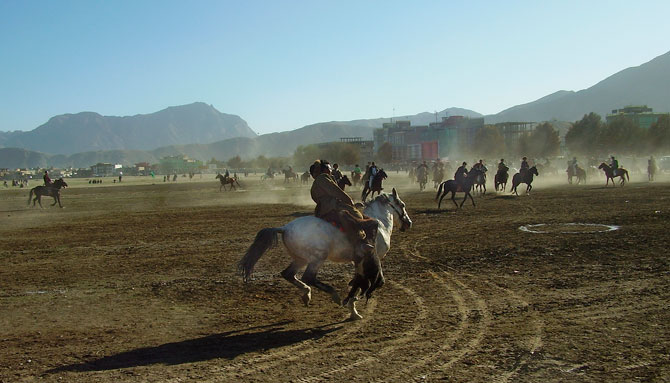 Buzkashi is the default national sport of Afghanistan. It's similar to polo except there are no teams, and instead of using a mallet and a ball, players swing down off their horses to pick up a headless goat and then try to drop it in a white circle near the center of the field.
Buzkashi is the default national sport of Afghanistan. It's similar to polo except there are no teams, and instead of using a mallet and a ball, players swing down off their horses to pick up a headless goat and then try to drop it in a white circle near the center of the field.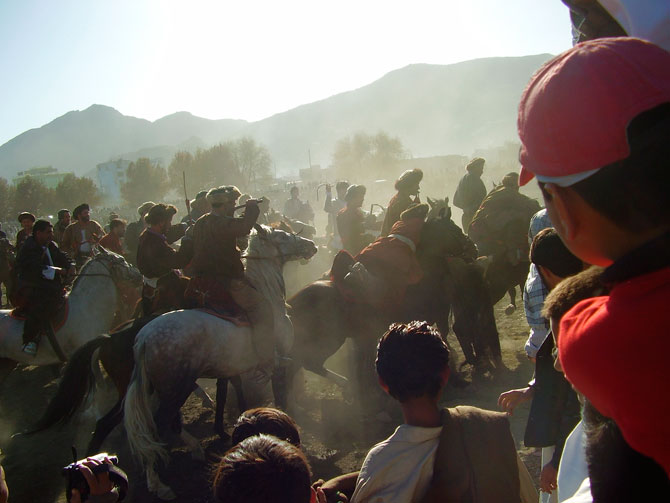
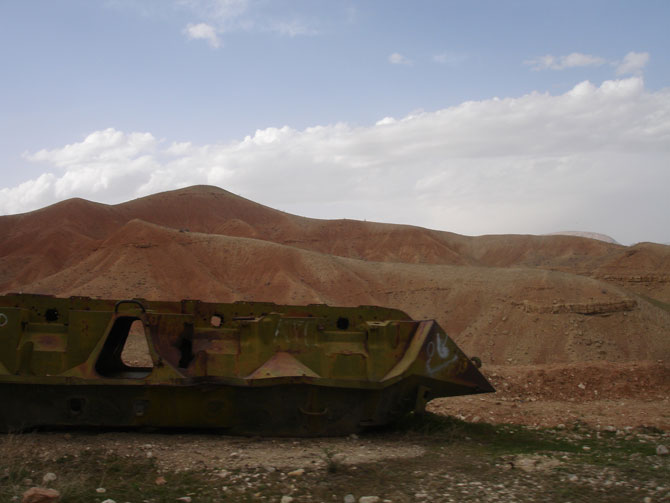 In this area you see a lot of bombed-out tanks. This one is most-likely an old Soviet one but it could be Northern Alliance. Anywhere that you see white rocks means that the area is mined. That is pretty much the case all over Afghanistan. You have to be really careful about every step you take.
In this area you see a lot of bombed-out tanks. This one is most-likely an old Soviet one but it could be Northern Alliance. Anywhere that you see white rocks means that the area is mined. That is pretty much the case all over Afghanistan. You have to be really careful about every step you take.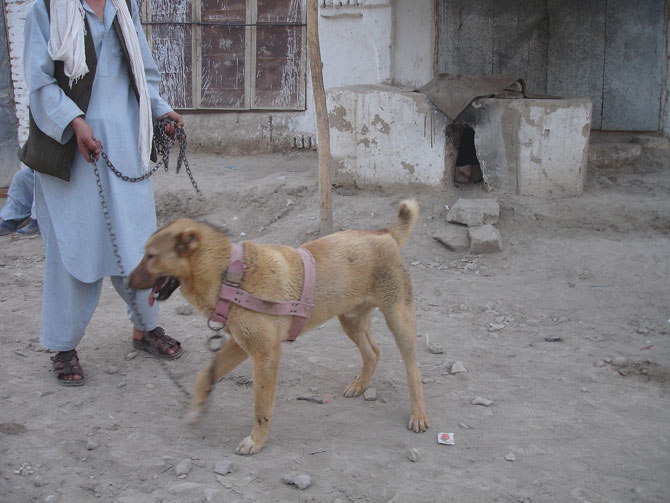 Pretty much everywhere I went I would see men walking pretty large distances to hold dogfights. It's really popular.
Pretty much everywhere I went I would see men walking pretty large distances to hold dogfights. It's really popular.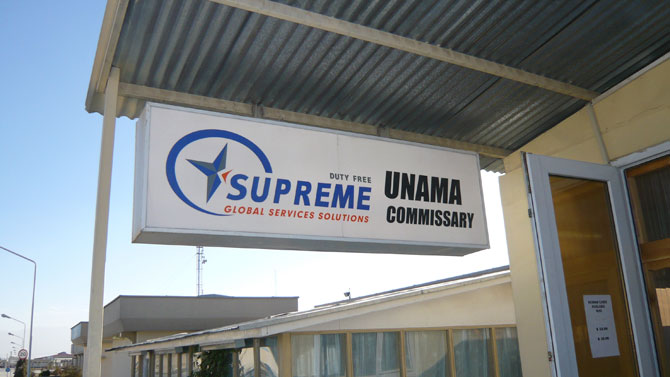 A Swiss company called Supreme run by Hasidic Jews was awarded the contract to provide food to military personnel and the UN staff in Afghanistan. They specialize in catering to war zones and high-risk environments. Considering that one of our major objectives is to provide jobs to the local people and keep money within the country, it's kind of contradictory awarding major, lucrative contracts like these to Western companies. As part of policy, they are not allowed to source any of the food domestically or hire Afghans to do the work or the cooking because of the threat of poisoning. Everything has to be imported.
A Swiss company called Supreme run by Hasidic Jews was awarded the contract to provide food to military personnel and the UN staff in Afghanistan. They specialize in catering to war zones and high-risk environments. Considering that one of our major objectives is to provide jobs to the local people and keep money within the country, it's kind of contradictory awarding major, lucrative contracts like these to Western companies. As part of policy, they are not allowed to source any of the food domestically or hire Afghans to do the work or the cooking because of the threat of poisoning. Everything has to be imported.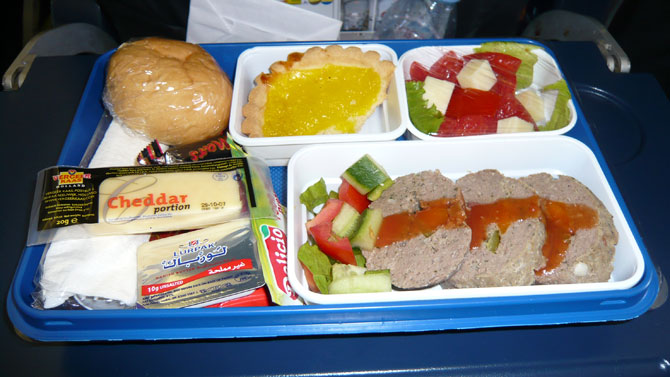 Their menu is chalk full of typical "American" foods. It isn't far off from cafeteria food you would get in an American high school. This is the kind of food I was getting on a daily basis at the office in Kabul. It's meatloaf pie.
Their menu is chalk full of typical "American" foods. It isn't far off from cafeteria food you would get in an American high school. This is the kind of food I was getting on a daily basis at the office in Kabul. It's meatloaf pie.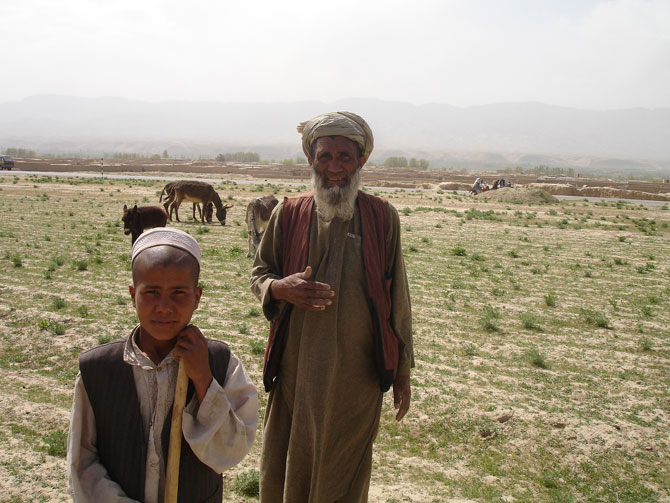 This photo was taken at a former opium field in rural Minamina province. You can tell that they had poppy plants in there until very recently because of how tight the rows are.
This photo was taken at a former opium field in rural Minamina province. You can tell that they had poppy plants in there until very recently because of how tight the rows are.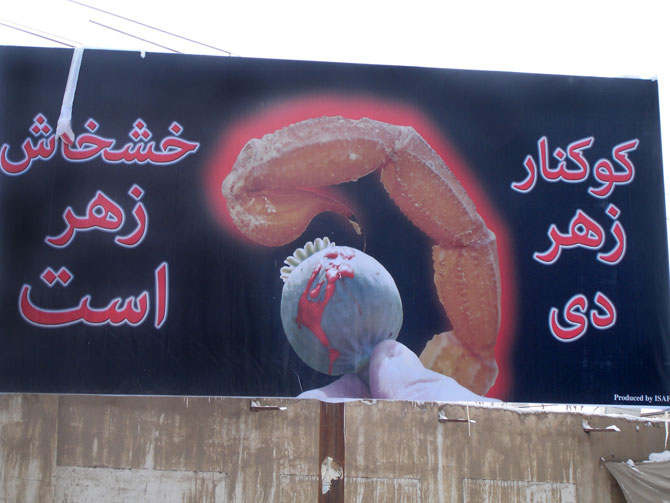 This billboard says poppy is poison in two languages. This is the NATO military presence. Hard to tell if you're only used to the Roman alphabet, but it's supposed to look like it was painted in blood.
This billboard says poppy is poison in two languages. This is the NATO military presence. Hard to tell if you're only used to the Roman alphabet, but it's supposed to look like it was painted in blood.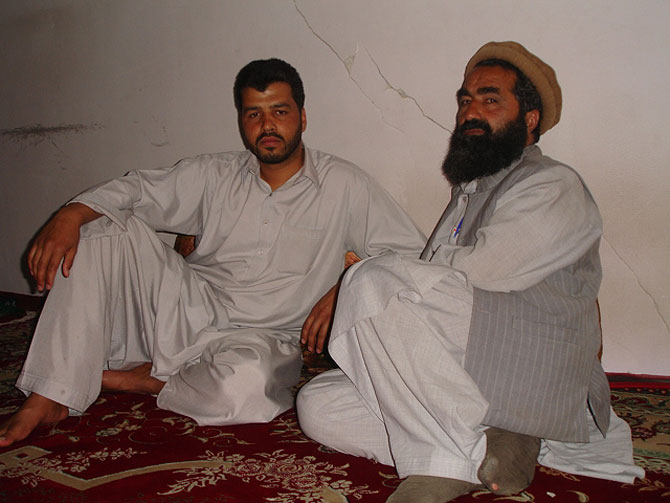 The is the governor of Faryabi province. Whenever we traveled for monitoring missions, we would be housed at the governor's residence. This would involve everyone on our team and probably some other people we didn't know sleeping in one big, carpeted room, all of us crowded in there like a slumber party. I found the governors, all of them, to be very hospitable and pretty awesome guys to hang out with. They were very serious about their jobs and they loved to smoke hash.
The is the governor of Faryabi province. Whenever we traveled for monitoring missions, we would be housed at the governor's residence. This would involve everyone on our team and probably some other people we didn't know sleeping in one big, carpeted room, all of us crowded in there like a slumber party. I found the governors, all of them, to be very hospitable and pretty awesome guys to hang out with. They were very serious about their jobs and they loved to smoke hash.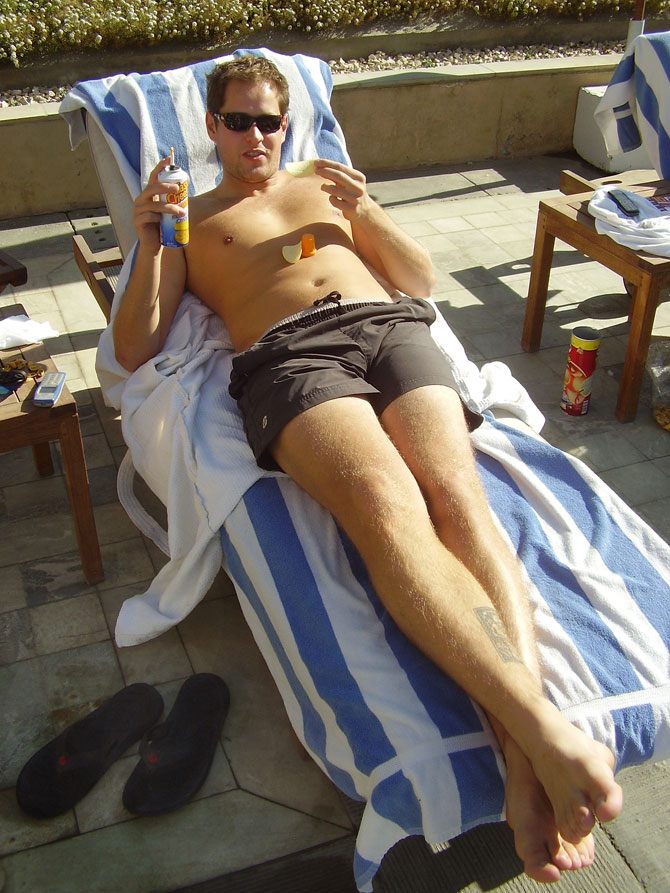 At times at the UN compound in Kabul, it felt like the opening chapter of that book Imperial Life in the Emerald City. It is like a walled off first-world in the center of Kabul where you can go and have a life that isn't all that different from something you'd be doing in the summer in the States. My friend here is eating Pringles and cheez whiz.
At times at the UN compound in Kabul, it felt like the opening chapter of that book Imperial Life in the Emerald City. It is like a walled off first-world in the center of Kabul where you can go and have a life that isn't all that different from something you'd be doing in the summer in the States. My friend here is eating Pringles and cheez whiz.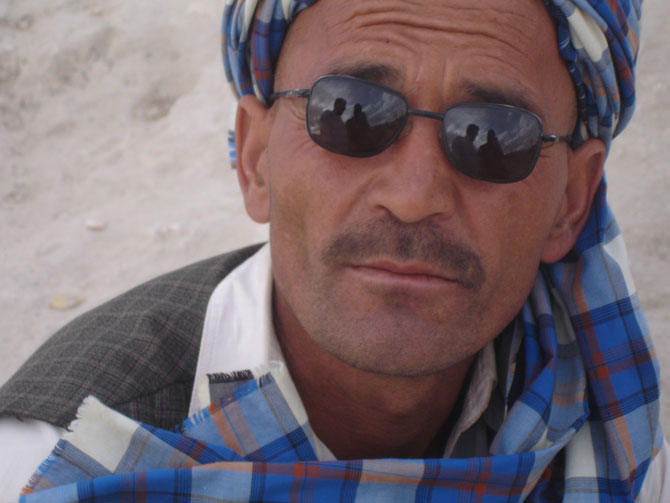 The Hazara are an ethnic minority in Afghanistan. They're of Mongolian origin and are said to have been descendants of Genghis Khan. They have been discriminated against really badly for the last 30 years. At one point in 2001, one of my colleagues came across several hundred Hazara widows. All of the men in their village had been murdered by the Taliban and all of the women had been raped, and they all wanted to die because they had been so disgraced. The women were literally begging him to kill them. He tried to convince them to come back into society, but it was futile so he got in touch with one of his superiors, who was a general in the Northern Alliance. He came down to this spot with his troops and they tried to negotiate with them. No one was able to convince them of any other options. They were adamant that they needed to die. In the end, the troops granted their wish and killed them all.
The Hazara are an ethnic minority in Afghanistan. They're of Mongolian origin and are said to have been descendants of Genghis Khan. They have been discriminated against really badly for the last 30 years. At one point in 2001, one of my colleagues came across several hundred Hazara widows. All of the men in their village had been murdered by the Taliban and all of the women had been raped, and they all wanted to die because they had been so disgraced. The women were literally begging him to kill them. He tried to convince them to come back into society, but it was futile so he got in touch with one of his superiors, who was a general in the Northern Alliance. He came down to this spot with his troops and they tried to negotiate with them. No one was able to convince them of any other options. They were adamant that they needed to die. In the end, the troops granted their wish and killed them all.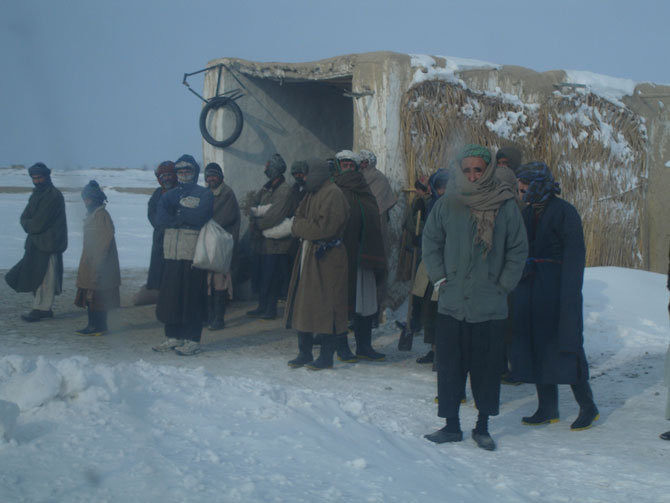 Migrant workers waiting at a bus stop somewhere near the Salang Pass in the North. As the picture suggests, it is freezing here during the winter. Traditionally, the way that Afghans keep warm around this part of the country is a stove called a bucharey, that is vented out through the wall of mud brick houses. It's a wood burning stove, however, which is a huge problem now because of the fact that during the war with the Soviets, the militants would hide in the wooded areas and to flush them out/kill them, the Soviets basically carpet-bombed the shit out of all the country's northern forests. These days, trees are very scarce.
Migrant workers waiting at a bus stop somewhere near the Salang Pass in the North. As the picture suggests, it is freezing here during the winter. Traditionally, the way that Afghans keep warm around this part of the country is a stove called a bucharey, that is vented out through the wall of mud brick houses. It's a wood burning stove, however, which is a huge problem now because of the fact that during the war with the Soviets, the militants would hide in the wooded areas and to flush them out/kill them, the Soviets basically carpet-bombed the shit out of all the country's northern forests. These days, trees are very scarce.
Annons

Chris Cole: I originally went to Afghanistan to do research for my postgraduate thesis in social anthropology on the effectiveness of the governance strategy being employed by the UN there. When I arrived it quickly became apparent that the security and political climates were changing so rapidly as to make my research plan completely unrealistic. I soon found a position working with the UN Development Program, which supports the Afghani government’s reconstruction efforts.Just for a little bit of scale, how would you describe the size of the area of Afghanistan that you covered while you were there?
I managed to get to nearly all of Afghanistan’s main regions, though typically on short, hectic monitoring missions that didn’t allow much time for exploring. The country is about the size of Texas and beyond the main ring road, which connects Kabul to the country’s other main cities—Kandahar, Heart, and Mazar-i-Sharif—the transportation infrastructure is poor. Traveling to remote provinces in winter often means many long days of driving on dangerous frozen roads in insecure areas.Were people friendly toward you?
Westerners who are not especially familiar with the history and social dynamics at work in Afghanistan tend to think that most Afghans are anti-American or Islamic extremists. The plain fact is that a very slim minority of the Afghan population—likely less than 1 percent—even tacitly sympathizes with the views of the Islamist Jihadis who make up the insurgency. Those families in Southern Afghanistan who allow insurgents to sleep in their homes and eat their food nearly always do so out of fear for their lives and because they cannot rely on NATO and Coalition troops to protect them. They don’t have some principle hostility toward Westerners or the Western way of life. While I was in the country I never felt as though I was the subject of any direct hostility. Afghans have a reputation for their hospitality that they live up to in my experience.
Annons
Afghanistan is a patchwork of different ethnic groups—Pashtun, Tajik, Uzbek, Turkmen, Hazara, etc, each of which groups has historically occupied a different part of the country. Pashtuns are the dominant ethnic group in the South and this is where the insurgency is most active. By contrast, across much of Northern Afghanistan, where Tajiks, Uzkbeks, and Turkmens dominate, there has been little violence since the 2001 invasion. People in these areas have a much easier time keeping extremist influence at bay in their districts since Pashtun-speaking people from the South are easily distinguishable from the local population.
Annons
It’s complicated. The foreign presence is improving people’s lives even though a lot of things are being screwed up in the process. According to the UN, infant mortality has decreased since the US invaded in 2001 and also the number of girls in school has increased measurably. However, frequent suicide bombings and consistent instability along the Southeastern border with Pakistan’s Federally Administered Tribal Areas are a reminder that there is still a war going on. And when our military forces accidentally kill thousands of civilians per year in bombing raids across Southern Afghanistan, it doesn’t go unnoticed by the public. Neither the occupying NATO and Coalition military forces, let alone the Afghan National Army, has a credible monopoly on the use of force in the country, a basic precondition for sustained and equitable socioeconomic development.So sounds like not quite so hot.
Well, having said all that, I think it’s important to point out that there’s no single force that’s driving this whole operation in Afghanistan. It can’t be denied that some NATO and Coalition actions seriously threaten the legitimacy of the peace building effort. But then, a recent Gallup poll found that better than 70 percent of Afghans would like foreign military forces to stay “for as long as it takes to defeat the Taliban and consolidate a democratic peace.”
Annons
I found that in general, Afghans do not have a negative opinion of Russians. It sort of surprised me because they were responsible for some really atrocious war crimes in Afghanistan, such as dropping candy bombs which entice children into picking them up and then having their limbs blown off. That was basically a strategy to force parents to stay home and care for wounded children so they couldn’t go out and fight. It seems bizarre that the Afghans would have a positive opinion of them, but I think it is because they look back to the 70s and early 80s and see that as a period of calm under the Communist regime. People said they felt like life was best then and things have degenerated a lot since then. Certainly the legacy of the Soviets is there for everyone to see in what amounts to a lost generation of men executed or maimed by mines and indiscriminate Soviet bombardment in the air and ground assaults. So yeah, kind of weird.

Annons






Annons




